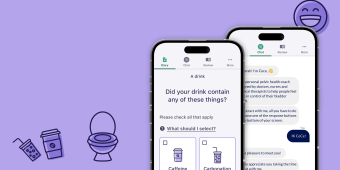COVID-19 chased us to our screens — now telemedicine may rescue healthcare

This article was written by Larry Schor, with support from TXI.
Advances in medical science over the last century have more than doubled the average life span. Yet our experience as patients is almost indistinguishable from the days of rotary dial phones.
Show me another industry that unselfconsciously stacks its customers into a public waiting room; then makes them wait some more, now half-dressed in an exam room, still with no idea when they’ll be seen. That patient experience looks ripe for disruption, yet it took a pandemic to force widespread change.
Fear of infection chased us to our screens and the novel experience of healthcare coming to us through the convenience of our computers and phones in the relative safety of our homes.
In a matter of days, the COVID-19 pandemic catapulted consumers into the 21st century healthcare experience we’d been missing. And we’re not going back to that “rotary dial healthcare.” It’s a message every hospital and health system in the country must heed, and an opportunity for bold leaders prepared to act on this shift in consumer attitudes and expectations.
Telemedicine Takeaways
The COVID-19 pandemic forced a tipping point for digital health adoption that transformed consumer expectations and created an opportunity for innovators to reinvent healthcare as a consumer-first connected care system. Now innovators must:
- Act with speed and conviction. Make the business case to invest in growing direct-to-consumer virtual care services that leverage incumbent advantages as caregivers –– or risk ceding the opportunity to innovators that will.
- Be strategic. Frame the implications of a permanent shift in consumer expectations and behavior as a strategic imperative and execute on a roadmap to implement digital front door plus remote monitoring solutions that build brand equity and “stickiness.”
- Define a coherent and integrated tactical product vision with room for expansion. Don’t toe-dip or be incremental. Invest in long term scale and growth. Exploit serendipitous rollout of 5G; it changes the feasibility and risk analysis and will enable extraordinary value-added and differentiated programming and products.
- Make virtual solutions business unit freestanding to avoid legacy business conflicts. This is not a skunkworks operation, nor is it the time for on-the-job learning for high-potentials eager to make a new mark. Recruit experienced leadership and tactical talent from outside the enterprise, with key positions filled from consumer digital and e-retail markets. Insulate the new business unit from predictable conflicts with the existing on-site health system operations, where the virtual solution’s mandate to prevent avoidable acute care utilization and reduce total costs of treatment will be disruptive.
The patient will see you now
This is not a time for tentative toe-dipping into virtual care. Going virtual is the new requirement for providers to retain their customers. Consumers are already differentiating the value of virtual care from legacy medicine: 36% reported they would switch their physician to have access to virtual care. Tech giants, in particular, Amazon, are not just lurking on the sidelines; they’re out in the open, building brand equity, scaling capacity, acquiring assets and talent, all in anticipation of a future state that has now arrived.
The implications of a market shift this fast and far-reaching are hard to overstate. If anything, it is a warning signal to industry stalwarts still rationalizing obsolete paradigms. Amazon's sweeping impact on our retail experience is an object lesson, eventually leading to a string of bankruptcy filings by fading retail giants.
More from TXI on healthcare
Why healthcare innovation is so critical
How 5G in healthcare will unlock telemedicine's potential
Simulating a wearable medical device to test IoT healthcare
We are witnessing a digital transformation in healthcare even more consequential than the shift to online shopping Amazon now dominates. Unlike retail, however, in the wake of the coronavirus the digital transformation of healthcare won’t take decades, but it, too, will leave behind the roadkill of digital laggards.
The business case for consumer-first virtual care
The Affordable Care Act of 2010 created work-arounds for the perverse incentives under fee-for-service medicine: an accountable care framework that pays providers more for value, defined as better outcomes and high quality, at the lowest possible total cost. Ten years after ACA became law, “value-based” pay-for-performance contracts are still tied to only 38% of total patient revenue for larger hospitals with more than 550 beds. The industry did not move fast enough toward value, and now the collapse in volume caused by the pandemic is an existential financial threat for many hospitals.
With the fee-for-service revenue model as the ground truth for most systems, the rationale to invest in digital transformation has often been the purview of the chief strategy or innovation officer. In other words, investing in digital to improve the consumer experience and reduce sources of friction and inefficiencies isn’t an all-hands imperative for hospital operations, but optional capabilities that are someone else’s priority. That was the status quo for many health systems until COVID-19 caused consumer demand for virtual triage to spike, and going virtual became the only way to deliver care now.
Consumer demand for all things virtual sets the stage for health systems to leverage their incumbent advantage as our caregivers when we’re sick by putting “health” back into our relationship by keeping us healthy in between appointments.
Our thesis is that health systems occupy a compelling competitive position to diversify their business and revenue models by offering a suite of virtual prevention and health maintenance services, with the connected consumer at the center.
This business case builds on long established consumer trends. Americans already spend $265 billion a year for physical activity and well-being services. Arguably, virtual services designed to keep us healthy is at least as compelling a value proposition as a health club membership or subscription to a wellness app. For about the average monthly cost of cable “triple play” service, health systems could offer an always-on virtual concierge that extends independence, preserves quality of life, enhances security and safety, etc. And, by preventing unnecessary or avoidable hospitalization, virtual care can also lower total out of pocket expenses.
We are already seeing early market signals of changing consumer preferences for wearables that favor this business thesis. Notably, consumers still report that fitness, training and weight loss continue to be important reasons for using wearables, but monitoring sleep and managing chronic disease are the only reported uses that increased year over year.
COVID-19 added pressure, but it didn’t create the cracks
Hospitals were already struggling with low operating margins and dependent on volume for elective procedures and ER admissions. If hospitals continue to slow-walk investments in digital transformation and fail to seize this moment, the consumer demand for virtual care will be exploited by bold innovators inside and outside the industry.
Specifically, the leading non-healthcare consumer brands — e.g., Amazon, Apple, Google — with vast resources and deep expertise in data science and prediction, personalization, mobile app design, and consumerism represent serious threats. If that happens at any level of scale, many health systems will lose control of their primary revenue channels and become commodity options where price dictates consumer choice.
Consumers welcomed the convenience and safety of virtual triage and assessment. That experience set the stage for health systems to become market markers of a portfolio of packaged virtual care solutions tailored to address distinctive needs for major demographic segment:
- Busy families with young children
- Adult children with aging parents
- Boomers, coming into their early 70s, who expect to remain active in retirement for another 10-20 years
- Aging seniors living longer, alone, and far from social support and family
- Anyone living with chronic condition(s)
- Vulnerable populations with challenging social risks and poor access to care
“You never let a serious crisis go to waste. And what I mean by that it's an opportunity to do things you think you could not do before.” — Rahm Emanuel, former Mayor of Chicago, quoting Winston Churchill
The pandemic is a black swan event that is testing leaders and management teams at every hospital in the country. It also creates a rare opportunity to articulate, fund and execute a clear strategy that puts the connected consumer in the center of a new DTC business strategy.
The tactics to realize that vision may differ, but the driving objective will be similar for all health systems: Augment transactional sick care treatment (covered in part by insurance) with virtual health maintenance services that consumers will buy and pay for and that creates the foundation of a sticky, branded relationship.
The roadmap for consumer-first connected care
In-person health care delivery is not going away, of course, but it will no longer be the center of the care delivery model. Instead, the consumer will be at the center. “Consumer-first connected care” meets the consumer where they are, at their convenience, on-demand and at a fair price — with the goal of proactive health maintenance. It is a more scalable and egalitarian version of so-called “concierge medicine.”
The Connected Care Model
In a connected care model, the familiar medical campus is no longer at the center of the consumer healthcare experience. The infrastructure and assets of consumer-first connected healthcare will be distributed with the patient at the center –– at home, school, work or play. The medical campus continues to offer advanced diagnostics and acute and intensive care, but it now adds the new interactive virtual studio functionality to support its evolving service model, leveraging its existing bench of expert human resources and the tools and data from remotely monitoring our risks and health status.
There is more than one way to build out the infrastructure and capabilities, but a practical order of priority is to start with virtual triage and assessment, often the use case for “digital front door” innovation initiatives that several health systems are in process of executing.
Virtual treatment and predictive virtual prevention are arguably the most important and transformative elements of a connected-care suite because they close the gaps in the prevailing treatment model that waits for risks to rise to a point where care is needed.
| Virtual Suite Roadmap | ||
| Virtual Service | Description | Revenue Model |
| Virtual triage | Co-exists as a real option at scale alongside traditional on-premises health delivery. Expect payers to use benefit design to steer consumers to virtual care, similar to financial inducements that compel consumers to use in-network providers, for initial triage and assessment, among other use cases. | No charge |
| Virtual care | Rapidly mainstreamed — the house call of a 21st century healthcare connected care model — and a core element of service delivery especially for virtual rounding, telediagnostics and common recurring therapeutic interventions for chronic illnesses such as behavioral health, diabetes, IBS, HIV, to name just a few use cases. | Fee for service with some insurance coverage |
| Virtual Prevention | Comprises a wide and expanding range of connected products, sensors, services and AI-powered smart signal processing products that extend the reach of trusted caregivers into our lives –– at home, work, school, and play –– to keep us healthy in between appointments (when all the bads actually happen). | SaaS sponsored by:
|
The applications and data analytic tools that power this vision are maturing quickly. A key component of the infrastructure that enables and underpins those smart applications and passive data-collecting sensors envisioned in the roadmap above is a ubiquitous wireless network with industrial grade SLAs.
Fortunately, this business proposition benefits from the serendipitous timing of the national rollout of fifth generation (5G) cellular technologies that delivers the reliability, speed, capacity, security, and ultra-low latency required to meet health system demands. In the long run, investing in 5G will also enable augmented reality that will become common elements of virtual care in the future. For more details on the impact and important healthcare benefits of 5G check out this article by my partners at TXI.
Machine learning algorithms screen all of that “chatty” fine-grain data to personalize programming and, most important, detect rising risks early enough to enable interventions that prevent unnecessary hospitalizations.
Once again, the design spec for this roadmap is driven by the goal of proactive health maintenance and customer service that delights the consumer. Nothing less than what Amazon, Apple, Google all strive to deliver. Each of the elements in a connected-care model can stand alone, but flexibility and impact are optimized when it’s delivered as a virtual care suite with a common architecture and shared data model.
Virtual 2.0 will be physical (the health system advantage)
Success building a scale virtual business favors extending brand value to physical assets, much in the way Amazon has counterintuitively opened real bookstores and fast retail outlets. Amazon’s massive virtual footprint, intelligent logistics and next day Prime fulfillment capabilities enables Amazon to customize stock in their physical stores to local demands, in a store typically a fifth the size of Barnes & Noble big boxes, with near-real time predictive inventory management that traditional brick and mortar cannot compete against on nearly any metric that consumer care about––price, convenience and catalog.
Health systems have an explicit advantage: consumers trust their doctors and affiliated hospitals more than any other industry. That trust framework is a bulwark for systems to build upon.
- New data sources and data science enables personalization and unprecedented engagement to detect disease and risk and add consumer value.
- Value, trust and access to services are all ingredients essential to activated engagement.
- Integrating virtual data insights into inpatient workflows adds another layer of competitive advantage and enables systems to drive more precise, higher quality inpatient care.
A health system’s branded virtual care business sets the stage for a differentiated and resilient revenue model that complements traditional fee-for-service, insurance coverage and at-risk contracting with a robust direct-to-consumer retail cash segment. Longer term, virtual care and virtual prevention equip health systems with the capacity to build the understanding of the rising risks that today are out of sight until the consumer gets sick enough to become a patient. Deep expertise in early clinical risk detection and risk mitigation are two keys to any rational business case for a health system to accept delegated financial risk under value-based contracts, destined to be a growing percent of total revenues.
Apple, Google, Microsoft and Amazon have all built trusted consumer brands. But when hospital-based care is eventually required, advantage will go to the health systems that can leverage trusted virtual relationships with consumers.
As the incumbent providers of virtual health maintenance, health systems will also be well-positioned to leverage and integrate insights culled from their virtual care solutions to inform diagnosis and inpatient treatment.
Finally, a high quality virtual care brand may also be the most effective way for a health system to build the competitive moat it will need to stay independent and ensure long-term financial viability.
COVID-19 launched virtual care into the zeitgeist, but connected applications and services will enable it to scale and, ultimately, outperform the current model. In this way, we can realize a vision for healthcare that dates back more than a decade: an integrated and accountable model of prevention and treatment that achieves the “triple aim + 1” — right care, right quality, right time and right place, at an exponentially lower cost plus a satisfied consumer who is sometimes, but only rarely, a patient.
Larry Schor is a digital health strategist and new market developer with more than 25 years of experience accelerating growth and performance for ventures at all stages of growth — from seed to scaling. He has extensive experience serving as a volunteer mentor, advisor and angel investor to Chicago-area startups at both MATTER and the Polsky Center for Entrepreneurship and Innovation.
Larry is also the founder and managing partner of Ilument Group, LLC., a management consultancy focusing on strategy and business development for decision analytics, predictive science, digital health tech and population health management for early and growth stage ventures.
Published by TXI Healthcare in Digital Health

Let's shape your insights into experience-led data products together.


